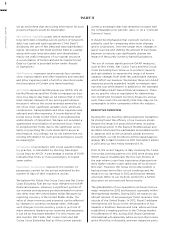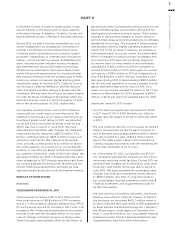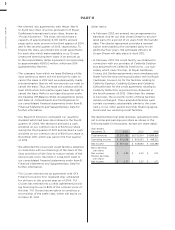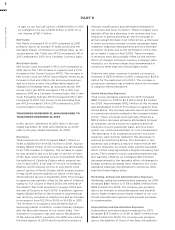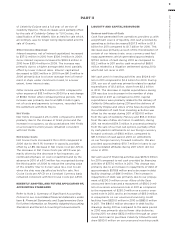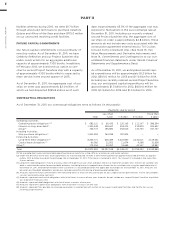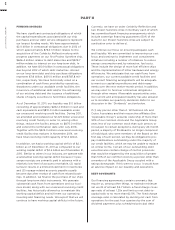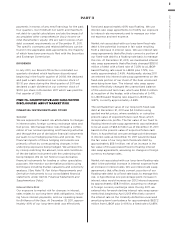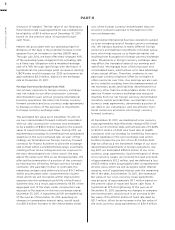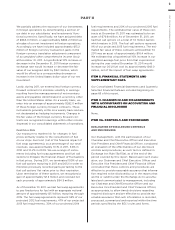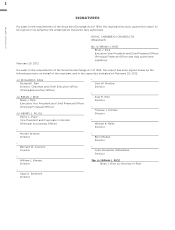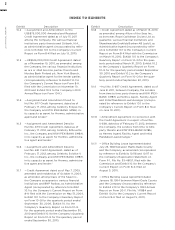Royal Caribbean Cruise Lines 2011 Annual Report Download - page 57
Download and view the complete annual report
Please find page 57 of the 2011 Royal Caribbean Cruise Lines annual report below. You can navigate through the pages in the report by either clicking on the pages listed below, or by using the keyword search tool below to find specific information within the annual report.
PART II
ROYAL CARIBBEAN CRUISES LTD. 53
As a normal part of our business, depending on market
conditions, pricing and our overall growth strategy,
we continuously consider opportunities to enter into
contracts for the building of additional ships. We may
also consider the sale of ships or the purchase of
existing ships. We continuously consider potential
acquisitions and strategic alliances. If any of these
were to occur, they would be financed through the
incurrence of additional indebtedness, the issuance of
additional shares of equity securities or through cash
flows from operations.
OFF-BALANCE SHEET ARRANGEMENTS
In July 2002, we entered into an operating lease
denominated in British pound sterling for the Brilliance
of the Seas. The lease payments vary based on sterling
LIBOR. The lease has a contractual life of 25 years;
however, both the lessor and we have certain rights to
cancel the lease at years 10 (i.e., 2012) and 18 (i.e., 2020)
upon advance notice given approximately one year
prior to cancellation. Accordingly, at the inception of
the lease, the lease term for accounting purposes was
established to be 10 years. In June 2011, the lessor
advised us that it would not exercise its right to cancel
the lease in 2012 and we subsequently made a deter-
mination that we will not exercise our right to cancel
the lease in 2012. As a result, we performed a lease
classification analysis and concluded that the lease
should continue to be classified as an operating lease.
In the event of early termination at year 18, we have
the option to cause the sale of the vessel at its fair
value and to use the proceeds towards the applicable
termination payment. Alternatively, we could opt at
such time to make a termination payment of approxi-
mately £66.8 million, or approximately $103.8 million
based on the exchange rate at December 31, 2011 and
relinquish our right to cause the sale of the vessel.
Under current circumstances we do not believe early
termination of this lease is probable.
Under the Brilliance of the Seas operating lease, we
have agreed to indemnify the lessor to the extent its
after-tax return is negatively impacted by unfavorable
changes in corporate tax rates, capital allowance
deductions and certain unfavorable determinations
which may be made by United Kingdom tax authori-
ties. These indemnifications could result in an increase
in our lease payments. We are unable to estimate the
maximum potential increase in our lease payments
due to the various circumstances, timing or a combi-
nation of events that could trigger such indemnifica-
tions. We have been advised by the lessor that the
United Kingdom tax authorities are disputing the
lessor’s accounting treatment of the lease and that
the parties are in discussions on the matter. If the
characterization of the lease is ultimately determined
to be incorrect, we could be required to indemnify
the lessor under certain circumstances. The lessor has
advised us that they believe their characterization of
the lease is correct. Based on the foregoing and our
review of available information, we do not believe an
indemnification is probable. However, if the lessor
loses its dispute and we are required to indemnify the
lessor, we cannot at this time predict the impact that
such an occurrence would have on our financial con-
dition and results of operations.
In connection with the sale of Celebrity Mercury, we
and TUI AG each guaranteed repayment of 50% of an
€180.0 million 5-year bank loan provided to TUI Cruises.
Based on current facts and circumstances, we do not
believe potential obligations under this guarantee
would be material to our results of operations.
TUI Cruises entered into a construction agreement
with STX Finland to build its first newbuild ship that
includes certain restrictions on each of our and TUI
AG’s ability to reduce our current ownership interest
in TUI Cruises below 37.5% through the construction
period. In addition, the bank credit facility agreement
associated with the financing of the newbuild extends
this restriction through 2019.
Some of the contracts that we enter into include
indemnification provisions that obligate us to make
payments to the counterparty if certain events occur.
These contingencies generally relate to changes in
taxes, increased lender capital costs and other similar
costs. The indemnification clauses are often standard
contractual terms and are entered into in the normal
course of business. There are no stated or notional
amounts included in the indemnification clauses and
we are not able to estimate the maximum potential
amount of future payments, if any, under these
indemnification clauses. We have not been required
to make any payments under such indemnification
clauses in the past and, under current circumstances,
we do not believe an indemnification obligation is
probable.
Other than the items described above, we are not
party to any other off-balance sheet arrangements,
including guarantee contracts, retained or contingent
interest, certain derivative instruments and variable
interest entities, that either have, or are reasonably
likely to have, a current or future material effect on
our financial position.



